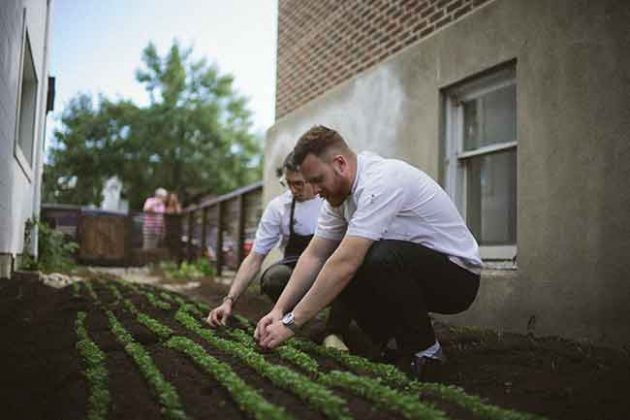
Going green
Colleen Cross
Features Business and Operations Premises energy star saving energy sustainability Chefs from LEAF-certified and sustainable Ox and Angela Restaurant and Tapas Bar in Calgary harvest micro greens from their dedicated market garden. The garden also supplies vegetables to sister restaurants UNA pizza + wine, UNA Takeaway and Frenchie Wine Bar. Photo courtesy of BMeX Restaurant Group
Chefs from LEAF-certified and sustainable Ox and Angela Restaurant and Tapas Bar in Calgary harvest micro greens from their dedicated market garden. The garden also supplies vegetables to sister restaurants UNA pizza + wine, UNA Takeaway and Frenchie Wine Bar. Photo courtesy of BMeX Restaurant GroupFor a growing group of your customers, personal values are more important than personal benefits such as cost or convenience.
This was the finding of a 2015 Nielson poll called “The Sustainability Imperative.” Sixty-six per cent of participants were willing to pay more to support businesses dedicated to social and environmental change, and over half of those people said they are influenced by sustainability factors such as a product being made from fresh, natural and/or organic ingredients and a company reducing its environmental impact.
Sustainability is a big word that encompasses water and energy conservation, food waste management, recycling, sourcing local ingredients and so much more. It can be hard to define and even trickier to explain to customers. “Corporate sustainability entails making decisions based on a long-term perspective. It is about making decisions that weigh the impacts of your businesses’ profitability, the people affected (including guests, staff and community), and the natural resources used,” says Lucy Cullen, a consultant with Terus, a Toronto-based sustainability consulting company for restaurants.
Pursuing a greener place on the restaurant landscape has clear benefits for the environment, but does going green provide payoffs to your bottom line? Many experts believe there is a clear business case for reducing the impact of your pizzeria on the environment. In The Sustainability Advantage sustainability expert and former IBM Canada executive Bob Willard shares seven benefits of becoming sustainable to your business’s bottom line, among them easier hiring of the best talent, higher retention of top talent, increased employee productivity and increased revenue and market share.
The bigger restaurant chains recognize sustainability as being good for business, says Bruce McAdams, a professor in the bachelor of commerce program in food and tourism management at the University of Guelph. “A & W was a leader in this with its beef program,” McAdams says. “In some locations it has also reduced packaging by giving diners the option of eating on ceramic instead of one-use plates.” He points to Pizza Nova’s development in 2015 of a pepperoni made without the use of antibiotics or hormones using Canadian-raised, vegetable- and grain-fed beef and pork as another example of the strong trend.
McAdams, who previously was vice-president of operations at Oliver and Bonacini Restaurant, helped spearhead the Sustainable Restaurant Program at University of Guelph in 2009. The program was designed to help the on-campus restaurant, PJ’s, run more sustainably.
“We stopped ordering the linen,” he says. “We bought our own and we did it in house. We did our research and found [doing our own laundry] uses fewer harsh chemicals and also that the level of greenhouse gases used to deliver the napkins is quite high. We eliminated straws, we took out as much plastic as we could, we started using creamers and milks in little jugs as opposed to the little packages. We did a sort of self-audit.”
They also applied to Leaders in Environmentally Accountable Foodservice, known as LEAF, and received certification. The project was such a success they decided to carry on with research – including a paper on reducing plate waste – and to expand it to connect with the restaurant industry through online discussion papers, a blog and an annual March symposium.
What can you as a pizzeria do to be kinder to the environment?
There are opportunities in every aspect of your restaurant’s menu and operation, from waste management to energy and water consumption, materials use and even staff training, Cullen says. “Installing LED lights, dimmers and light sensors, implementing on-off schedules for lighting and appliances, or even turning off door heaters for reach-in refrigerators are all good strategies,” she says.
Lots of these strategies are quickly implemented and painless. “Something that can be easily done is ensuring waste bins are placed efficiently in the dish pit. The compost bin should be the most efficient for staff to use, since most waste from the dining room is food waste. This can reduce the waste placed in your garbage and in turn reduce your waste haulage costs,” she says.
Both McAdams and Cullen suggest switching to appliances such as washers and dryers that bear the Energy Star symbol, a mark that means they meet or exceed high efficiency standards and typically are in the top 15 to 30 per cent of their class for energy performance. “There is a year-and-a-half to five-year payback in the amount of energy you will save,” McAdams says.
“Have a water audit done by your city or municipality,” he suggests, adding that these are free and give you a report with steps to help you reduce water consumption by 30 per cent.
The audit on PJ’s recommended they change the aerators on their sinks so that less water flows, especially in sinks used mostly for tasks like thawing food. One “no-brainer,” McAdams says, is to go to your dishwasher supply company and ask questions. “Use that relationship. They will help educate staff on such things as putting through only full loads and give you signage, training and testing of the chemicals you are using.”
One thing restaurant operators can do to reduce electricity output is to look at the level of business over different time periods and adjust equipment use based on that, McAdams says. “For example, if you do pizza and wings, and on Monday nights it’s really slow, don’t turn on your second deep fryer. If you’re coming in at 12 and your cooks come in at 9 a.m. and turn everything on right away, have them hold off until they need the equipment at 10:30 or 11.” All of these are little things operators can do that can have big impacts on your conservation, he says.
SOURCING RESPONSIBLY
Cullen suggests putting more thought into where you buy ingredients. For example, consider using seafood certified by Ocean Wise, a Vancouver Aquarium conservation program that educates consumers about issues surrounding sustainable seafood. “The Ocean Wise symbol is placed next to the seafood item on your menu, communicating these initiatives to your guests,” she says.
Sourcing seasonally and locally is very important and something guests get excited about and demand, Cullen says. But because it can be difficult to offer food that is completely local and seasonal, it’s very important to be transparent about what is local and what is not. “The last thing you want is to advertise how local your Toronto-based restaurant is, then have avocados on your menu from South America,” she says.
FOOD AND PACKAGING WASTE
As for reducing food waste, McAdams suggests keeping track of what you sell through a POS or another system and analyzing the data. “There’s a huge relationship between being able to track waste and then look back at it. For pizzerias, it’s about being really aware of what you’re throwing out, then working backwards to forecast and put systems in place that will help you limit waste,” he says. Cullen suggests making vinegars out of fruit scraps, donating coffee grounds to be made into fertilizer or donating edible food to organizations such as Second Harvest in Toronto.
When it comes to recycling packaging and food waste, the trend is toward more composting, McAdams says. “I think you’ll see in three or four years across Canada – and in Vancouver it’s happening now – that government is really trying to limit the amount of organic waste that goes to landfill. Waste in landfills produces methane; that is not the case with composting.” He says indications are that within two years Ontario restaurants will be responsible for recycling not only their own tins and plastics but also their organic matter.
Take-out packaging is huge, McAdams says. He and his students did a study on a restaurant, giving it a list of options. The study found most options were cost-prohibitive in the end. “Unfortunately, polystyrene is going to cost less than other things,” he says, “but there is so much information out there to make wise choices. It comes down to post-consumer use products, recycled packaging and educating yourself.”
“Converting to using hand dryers instead of paper towels will reduce your restaurant waste, and can result in up to 98 per cent savings, by eliminating the maintenance and operating costs associated with paper towels,” Cullen says. “In one case study, a restaurant that used 90 cases of paper towels annually had an associated cost of $2,025. Compared to the operating costs of $96 for operating a hand dryer, there is an annual savings of $1,929 after the initial investment of the hand dryer.”
Training your staff is challenging but important, Cullen says. “During times of high pressure and high turnover at a restaurant, maintaining the right environmental processes – for example, putting the right waste in the right bins – falls to the staff. They need to be a part of the sustainability efforts of a restaurant, so that they internalize the importance of undertaking the programs that will make sustainability successful. Train your staff well and then recognize them for their sustainability efforts: consider having a prize for the greenest employee of the month.”
McAdams, too, sees staff buy-in and training as key. “Get front counter staff, when they are selling a pizza slice in a bag, to ask customers if they would like a napkin as opposed to just giving them six.” One-use items such as plastic straws, napkins and condiment packs, are a huge source of unnecessary waste, he says.
INDEPENDENTS: ‘THINK BIG!’
While large franchises may have more resources for chain-wide sustainability campaigns, independent shops have more freedom to decide on a strategy and run with it. “Franchise managers are limited in what they can do,” McAdams says. “With them, training is so important. Focus on training staff to be mindful in their actions, and question corporate policies where you can.” Independents, on the other hand, have more freedom to make operational changes because they have more control of their premises. “To the independents, I say, ‘Think big!’ ”
His biggest piece of advice: put someone in charge of your pizzeria’s sustainability efforts. “It has been shown that businesses that have a green, or sustainability, champion will reduce their environmental impact more than businesses that don’t have a champion.”
“It is amazing what you can do,” he says.
COMMUNICATE YOUR EFFORTS
With all the work you are doing, it’s important to tell your customers and suppliers about your efforts. Communicate any initiatives through your menu, website and regular posts on social media, Cullen says. “If you have a local supplier, give them a shout out on Instagram. Or if you have eliminated bottled water, announce it on Twitter,” she says.
“Staff training and engagement is one of the most important ways to communicate your efforts to guests, because they are the face of your establishment. It is important that you are completely transparent about your initiatives, Cullen says. “Make sure your servers and other staff are well informed, so that they can tell your guests about your sustainability programs, and avoid blanket statements like ‘We are sustainable.’ This could mean any number of things, and will come across as greenwashing to your guests. Be specific about what you are doing, and what you are working on improving,” she says.
“One way to share what you are doing is through certification,” McAdams says. Most certification is done through LEAF.The Green Restaurant Association out of the U.S. does some in Canada as well, he says, and these organizations will help you promote your pizzeria’s efforts.
CALGARY PIZZERIA GOES GREEN
Jayme MacFayden and Kelly Black are two champions of sustainability. The couple’s Calgary restaurants, which include UNA pizza + wine, are certified through LEAF. The entrepreneurs sought certification from LEAF five years ago after they had an audit done on their pizzeria. They were seeking access to services and information from the organization and its partners and were impressed by the useful recommendations the audit provided.
“We are very conscious of what we bring into our house and what we put out of it and the energy that we use and where it’s coming from. That is something we wanted to carry over into our business, especially when you see how much waste a restaurant can generate.”
That initial audit was extensive, she says. They looked at chemicals, equipment, light bulbs, and checked invoices going back a year. Once that was done, however, it’s a matter of paying a fee every year to maintain their certification.
Their list of initiatives is ambitious and long. They use Bullfrog Energy, a renewable energy company, as their provider, by paying their regular energy bill, then paying more on top to support the
provider’s efforts. They make some of their cleaning products, which are all natural and biodegradable. They use Energy Star-certified equipment and LED lights, compost extensively.
On the ingredient side, they work with YYC Growers, which is a network of 14 urban farmers who grow organic and heirloom produce on unused properties in Calgary. “Initially we worked with one farmer, but when we began working with YYC Growers, we were able to give him a wish list of what we were looking for,” she says. “It helps to let your suppliers know what your costs would be to source from out of the country. If they know what you are trying to do, they will work with you to find a happy medium,” she adds.
Four years ago they created their own 1,300-square-foot garden beside one of their restaurants where they grow 50 different kinds of plants and flowers for use in the restaurants. “We harvest our rain water to water the plants and everything is planted with heirloom seeds and the garden is completely organic.”
In the future, MacFayden says, “it would be great to fully bridge that gap from farm to table by being involved with a farm or owning a farm.”
For now, she and Black are happy to champion the many ways restaurants can limit their impact on their surroundings. Sustainability means thinking about how who and what your actions affect, she says. “Every decision we make we want to be a thoughtful one.”
5 sustainability resources
- The Sustainability Learning Centre (SLC) – www.sustainabilitylearningcentre.com/
- Leaders in Environmentally Accountable Foodservice (LEAF) – leafme.ca/green-restaurants/
- Green Restaurant Association – www.dinegreen.com/
- Energy Star for products – www.nrcan.gc.ca/energy/products/energystar/12519
- Second Harvest food rescue program – www.secondharvest.ca/about
Print this page


